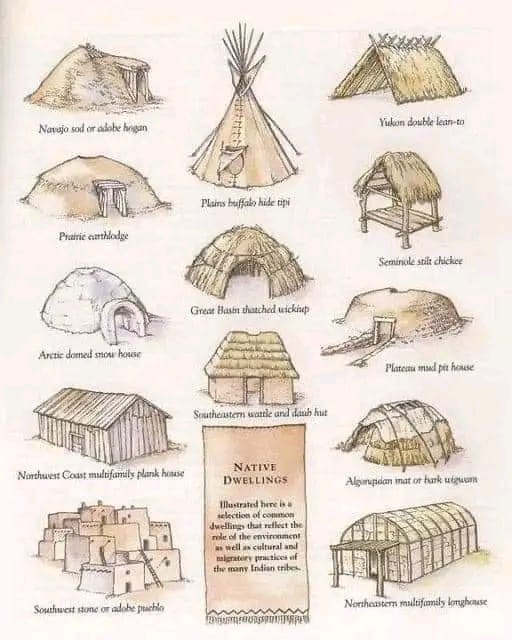Today is:

Since North America is such a big
continent, different tribes had very different weather to contend
with. In the Arizona deserts, temperatures can hit 120 degrees
Fahrenheit, and in the Alaskan tundra, -50 is not unusual.
Naturally, Native Americans developed different types of dwellings
to survive in these different environments. Also, different American
Indian tribes had different traditional lifestyles. Some tribes were
agricultural-- they lived in settled villages and farmed the land
for corn and vegetables. They wanted houses that would last a long
time. Other tribes were more nomadic, moving frequently from place
to place as they hunted and gathered food and resources. They needed
houses that were portable or easy to build. Here are descriptions
and pictures of some of the Native American house styles the people
developed over the years to fit these needs.
Native
American Homes
Wigwam Homes
Wigwams (or wetus) are Native American
houses used by Algonquian Indians in the woodland regions. Wigwam is
the word for "house" in the Abenaki tribe, and wetu is the word for
"house" in the Wampanoag tribe. Sometimes they are also known as
birchbark houses. Wigwams are small houses, usually 8-10 feet tall.
Wigwams are made of wooden frames which are covered with woven mats
and sheets of birchbark. The frame can be shaped like a dome, like a
cone, or like a rectangle with an arched roof. Once the birchbark is
in place, ropes or strips of wood are wrapped around the wigwam to
hold the bark in place. Here are some pictures of a woman building a
wigwam. Wigwams are good houses for people who stay in the same
place for months at a time. Most Algonquian Indians lived together
in settled villages during the farming season, but during the
winter, each family group would move to their own hunting camp.
Wigwams are not portable, but they are small and easy to build.
Woodland Indian families could build new wigwams every year when
they set up their winter camps.
Longhouses
Longhouses are Native American homes used
by the Iroquois tribes and some of their Algonquian neighbors. They
are built similarly to wigwams, with pole frames and elm bark
covering. The main difference is that longhouses are much, much
larger than wigwams. Longhouses could be 200 feet long, 20 feet
wide, and 20 feet high. Inside the longhouse, raised platforms
created a second story, which was used for sleeping space. Mats and
wood screens divided the longhouse into separate rooms. Each
longhouse housed an entire clan-- as many as 60 people! Longhouses
are good homes for people who intend to stay in the same place for a
long time. A longhouse is large and takes a lot of time to build and
decorate. The Iroquois were farming people who lived in permanent
villages. Iroquois men sometimes built wigwams for themselves when
they were going on hunting trips, but women might live in the same
longhouse their whole life.
Tepees
Tepees (also spelled Teepees or Tipis) are
tent-like American Indian houses used by Plains tribes. A tepee is
made of a cone-shaped wooden frame with a covering of buffalo hide.
Like modern tents, tepees are carefully designed to set up and break
down quickly. As a tribe moved from place to place, each family
would bring their tipi poles and hide tent along with them.
Originally, tepees were about 12 feet high, but once the Plains
Indian tribes acquired horses, they began building them twice as
high. Tepees are good houses for people who are always on the move.
Plains Indians migrated frequently to follow the movements of the
buffalo herds. An entire Plains Indian village could have their
tepees packed up and ready to move within an hour. There were fewer
trees on the Great Plains than in the Woodlands, so it was important
for Plains tribes to carry their long poles with them whenever they
traveled instead of trying to find new ones each time they moved.
Grass Houses Grass houses are American
Indian homes used in the Southern Plains by tribes such as the
Caddos. They resemble large wigwams but are made with different
materials. Grass houses are made with a wooden frame bent into a
beehive shape and thatched with long prairie grass. These were large
buildings, sometimes more than 40 feet tall. Grass houses are good
homes for people in a warm climate. In the northern plains, winters
are too cold to make homes out of prairie grass. But in the southern
plains of Texas, houses like these were comfortable for the people
who used them.
Wattle and
Daub Houses
Wattle and daub houses (also known as asi,
the Cherokee word for them) are Native American houses used by
southeastern tribes. Wattle and daub houses are made by weaving
rivercane, wood, and vines into a frame, then coating the frame with
plaster. The roof was either thatched with grass or shingled with
bark. Wattle and daub houses are permanent structures that take a
lot of effort to build. Like longhouses, they are good homes for
agricultural people who intended to stay in one place, like the
Cherokees
|
![]()
![]()